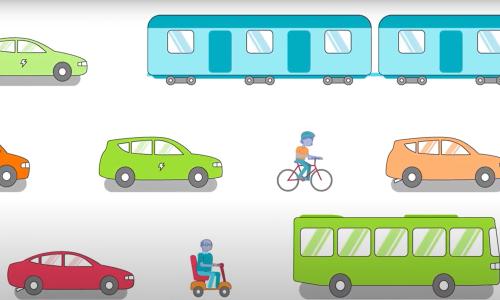Background
In 2002, the California state legislature passed the groundbreaking law, AB 1493, limiting global warming pollution from passenger vehicles. In 2004, the California Air Resources Board (CARB) adopted the standards mandated by this law, requiring automakers to achieve significant fleet-wide reductions in global warming pollution from their passenger vehicles and light-duty trucks by 2016. These global warming standards supplement California’s previous vehicle regulations, which include standards for air pollutants and the production of zero-emissions vehicles. Together, this suite of standards is known as the clean car standards. Under Section 177 of the Clean Air Act, any other state is allowed to adopt these standards, as long as they are at least as stringent as the federal standards and California has received the requisite “waiver” from the US EPA.
What do the clean car standards include?
Known collectively as the clean car standards, these rules encompass three areas of standards for cars and trucks: air quality, global warming, and zero-emission vehicles. The air quality standards set limits on soot and smog-forming pollutants; the global warming standards regulate carbon dioxide and other heat trapping gases; and finally, the Zero-Emission Vehicle standards require auto companies to produce ultraclean gasoline and hybrid vehicles in the states that have adopted these standards.
Air Quality Standards
The air quality section of the standards covers the smog-forming pollutants from vehicles, such as nitrous oxides, hydrocarbons, carbon monoxide and particulate matter. These are essentially the same as the federal standards for these pollutants, and would require very few changes in states adopting the clean car standards.
Global Warming Standards
The global warming portion of the standards regulates the emission of heat trapping gases, such as carbon dioxide, methane, and refrigerants used in air conditioning systems. Currently, there are no federal regulations that limit the emissions of global warming gases from vehicles. The regulation requires that the maximum feasible global warming emission-reductions from passenger vehicles and light trucks be achieved in a cost-effective manner. These standards apply only to vehicles weighing less than 10,000 pounds, with more stringent emission limits for cars than for trucks. These standards were to become effective with model year 2009 (1) to achieve a 30% reduction in global warming pollution from new vehicles by 2016. (2) The California Air Resources Board has begun work on the second phase of the standards, often referred to as the “Pavley 2 Standards” (in reference to Assemblywoman Fran Pavley who authored the original bill), which will regulate fleet-wide emissions from 2016 through 2020.
Zero emission vehicles standards
The Zero-Emission Vehicle standards direct auto companies to produce a wide range of zeroemission vehicles in the states that have adopted the clean car standards, including batteryelectric, hydrogen fuel-cell, and ultra-clean gasoline vehicles. Some states have opted not to adopt this portion of the clean car standards, while moving ahead with the air quality and global warming portions of the regulations.
Does this pre-empt my state’s authority?
No. A state must actively choose to adopt the clean car standards, which often means an affirmative vote by the state legislature. The state can also choose to revert back to the federal standards at any time.
Which other states have adopted the California clean car standards?
Thirteen other states and the District of Columbia have adopted the clean car standards: Arizona, Connecticut, Maine, Maryland, Massachusetts, New Jersey, New Mexico, New York, Oregon, Pennsylvania, Rhode Island, Vermont and Washington. Several others are actively perusing or considering adoption: Colorado, Florida, Illinois, Iowa, Minnesota, Montana, North Carolina, and Utah. The California Air Resources Board conducted an analysis in May 2008 and found significant benefits from the implementation of the standards by these 15 states (including California and DC). By 2020, implementing the planned Clean Car Standards in these 15 states will reduce cumulative global warming emissions by 451 million metric tons of CO2E (3), a 43% improvement compared to the proposed federal Corporate Average Fuel Economy (CAFE) standards. As more states adopt the clean car standards, the benefits will increase.
Do we need these standards in addition to the new federal CAFE standards?
The clean car standards reduce global warming pollution from passenger vehicles more than the minimal, proposed federal CAFE standards. The federal standards passed in the 2007 Energy Independence and Security Act require a minimum fleetwide average of 35 miles-per-gallon (mpg) for light-duty vehicles by 2020. By contrast, the estimated fleet average fuel economy equivalent of California’s planned 2020 standards, when adopted by other states, is 39.2 mpg. (4) Further, it should be noted that CAFE standards are not designed specifically to reduce the greenhouse gas pollution from vehicles and thus do not address, for example, air conditioning refrigerant leakage and A/C component efficiency - which are addressed by the clean car standards, and can result in even greater global warming emission reductions from vehicles.(5) These standards also lay the groundwork for implementation of stricter standards in the future, and will help states generate the institutional capacity to specifically regulate global warming pollution from mobile sources. This will prove important as the U.S. EPA moves ahead with national global warming standards for vehicles – a process that will be strengthened and improved by California’s early and rigorous regulatory action.
Notes
(1) Implementation was delayed under the Bush Administration when the EPA refused to grant CA the requisite waiver to move ahead. The situation changed in January 2009, when President Obama ordered that the waiver application and decision be reconsidered by the EPA based on scientific analysis. Experts expect that the waiver will soon be granted, allowing states to move ahead with implementation.
(2) California Air Resources Board, 2008. “Comparison of Greenhouse Gas Reductions for the United States and Canada Under ARB GHG Regulations and Proposed Federal 2011-2015 Model Year Fuel Economy Standards. An Enhanced TechnicalAssessment, February 25.”
(3) CO2 Equivalent. The amount of any greenhouse gas that contributes the same global warming impact as a ton of CO2.
(4) Same as 2.
(5) The clean car standards are stated as grams of GHG per mile and do not directly equate to miles-per-gallon. They require GHG emission reductions, and do not directly regulate fuel economy. This calculation also assumes a 50/50 fleet mix between cars and trucks. If the market share of cars increases, fleetwide fuel economy will increase, as the clean car standards are more stringent for cars than for trucks.



